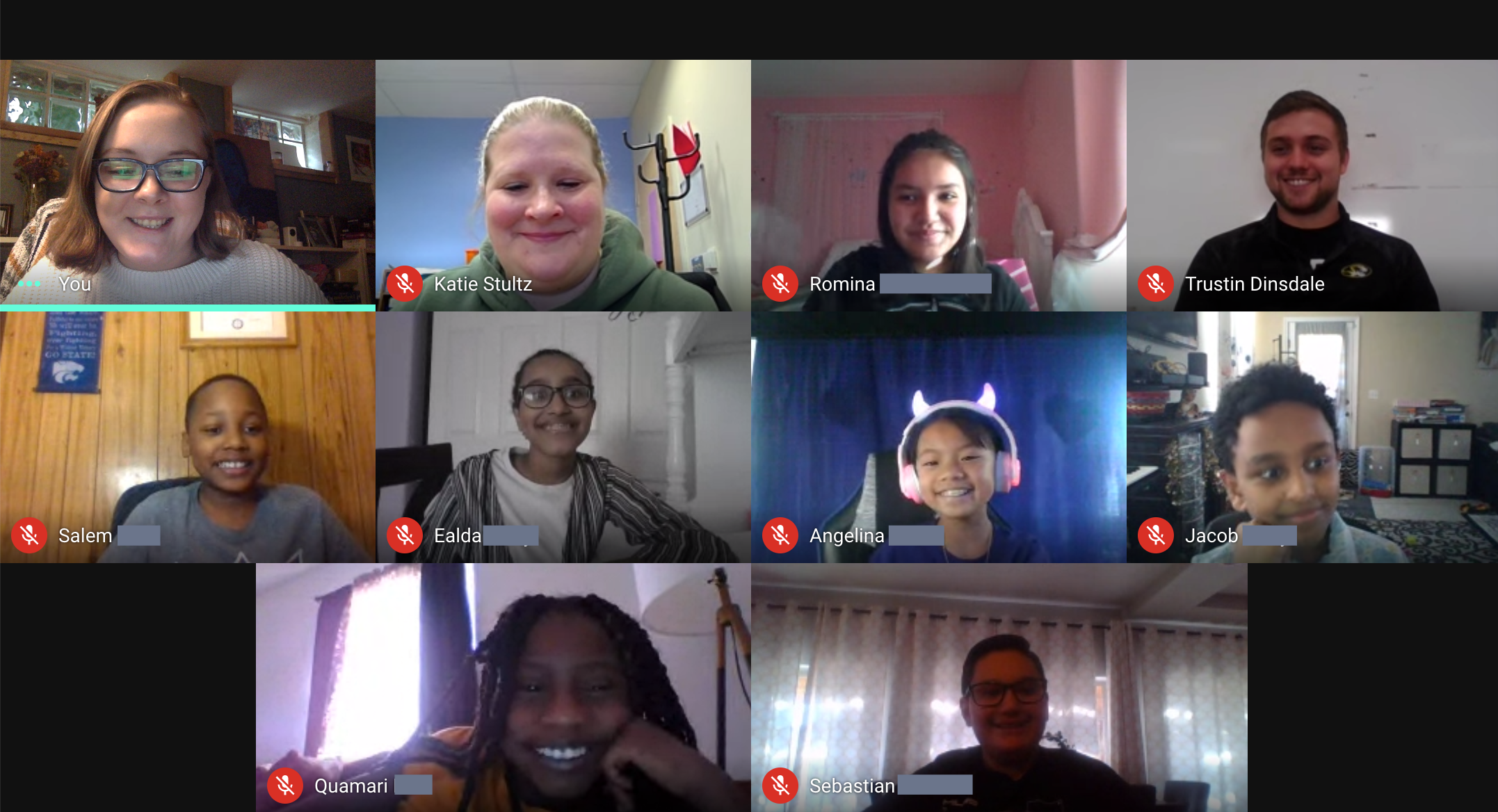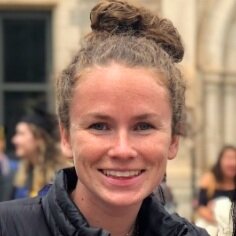Like most of us, K-8 students at Omar D. Blair Charter School in Denver, CO have spent the last year wrestling with the mute button on their computers. They have also struggled with time management, persevering through distractions while learning at home alongside siblings and telecommuting parents, and maintaining relationships in the face of social distancing.
.png)
Students and staff at Omar D. Blair Charter School engage in a conversation about virtual learning with Whitney Emke, ANet’s Director of Partnership Engagement
Teachers and leaders have felt the strain of virtual learning too; they have been thinking constantly about driving student engagement during virtual learning while maintaining student access to equitable, grade-level content, all in addition to carrying their own pandemic burdens. Despite these challenges, though, Omar D. Blair has achieved success with virtual learning. Student engagement in particular is up and everyone is learning more than ever about the process behind teaching and learning as they have been forced to re-examine previous practices and mindsets and make shifts.
Virtual learning has afforded students, teachers and leaders the opportunity to reflect on their role in the teaching and learning process and to learn lessons they will carry with them in the future.
Some students have felt so engaged and enjoyed the comforts of learning from home so much over the last year that they have no plans to return to the classroom anytime soon. Fifth-grader Ealda S. in particular has enjoyed the additional time with her family during virtual learning and likes being able to check in with her little brother, a third-grader, midday to see how he is doing and what he is learning.
Other students, like fifth-grader Sebastian A., are eager to get back in the classroom but hoping things look a little different when they go back. Sebastian has enjoyed the variety of activities teachers have prepared during virtual learning and hopes that teachers continue to make school fun once they are back in the building. He also realized that he may have been his own worst enemy while in the classroom; Sebastian says that over the last year, he has been significantly less likely to “get in trouble for being so chatty.” He says that when he returns to the classroom, he plans to “chat” less and work harder.
Teachers have learned valuable lessons too. Much like Sebastian, fifth-grade teacher Raenon Renfroe realized she may have been a little too chatty before making the move to virtual learning; she recently had an encounter with a student where she gave a long, convoluted explanation for a mathematical strategy only to have them point out that they already knew a much simpler strategy. The experience made her realize, “I talk way too much,” and she says that she will scale it back when Omar D. Blair returns to the classroom.
Dean of Instruction Tom Ponce agrees that teachers may have been unintentionally over-scaffolding for their students prior to the pandemic, which undoubtedly came from “a place of love.” He says that being forced to empower students to advocate for themselves, problem solve and think critically on their own over the last year allowed teachers and leaders at Omar D. Blair to better understand just how much their students are capable of—not to mention allowing students to see just how much they are capable of—and has enabled the school to thrive in the face of virtual learning.
Teachers and leaders credit much of the success Omar D. Blair has achieved during virtual learning to their partnership with ANet and the groundwork laid by their coach during the two years prior.

Kristen Williams, Principal

Katie Pilley, K-5 Academy Director

Tom Ponce, 6-8 Dean of Instruction

Brandi Phillips,
ANet coach
ANet Senior Director of School Support Brandi Phillips has worked with Principal Kristen Williams and other members of Omar D. Blair’s instructional leadership team since the 2018-2019 school year. Now in their third year of partnership, things just really “clicked” this year. The timing was especially fortunate given the extreme set of circumstances teachers and leaders were faced with. Phillips has worked alongside school leaders as they focused on three major facets: equitable content, feedback and assessment, and student experience, which together make up the building blocks of virtual instruction.

Teachers and leaders heavily utilized ANet’s coaching and resources this year and in years past to ensure students had access to equitable content, especially for math. Teachers were able to ground their lesson planning in the mathematical standards by using myANet to support them. myANet is an online platform that allows teachers and leaders at ANet-partnered schools to study and unpack standards, understand their students' data, and create and administer quizzes aligned to grade-level standards and high-quality texts. Teachers also used ANet’s schedule of assessed standards to check their pacing, ensure that they were teaching grade-level content, and make vertical connections between grade levels that allowed them to de-silo their planning and instruction.
A coinciding shift to standards-based grading for math changed the way that teachers, families and students at Omar D. Blair thought about feedback and assessment this year. This shift had an impact on student engagement and ultimately, student experience because it allowed everyone to stop focusing on just getting the right answer and to instead celebrate the effort and process behind learning and comprehension. This celebration of the learning process increased resiliency in students and significantly boosted student engagement.
Another key strategy for increasing student resiliency and ultimately improving student experience this year was the re-imagining and re-implementation of a practice called Figure It Out Fridays.
As Tom Ponce says, “remote learning makes it easier to opt out of engagement,” but in their second semester in particular, students at Omar D. Blair have been opting in. Those who may have been quieter in the first semester are feeling like they have the opportunity to try again. A big driver here has been an emphasis on the “yet” in not getting the answer right yet, which has been especially evident as teachers re-envisioned what Figure It Out Fridays might look like in a virtual space.

Allie Crimmins, 3rd grade teacher

Raenon Renfroe, 5th grade teacher
Figure It Out Fridays were originally created to drive student engagement and “integrate student lift and student talk into more of our math classes,” says third-grade teacher Allie Crimmins. It was a learning process for teachers and students alike as they shifted from “doing application problems a couple of times a week to having a full day devoted to grappling with higher-level concepts or looking at math problems that don’t necessarily have solutions.” Moving the process online this year has been a massive undertaking that required constant reflection and tinkering as teachers worked to engage students virtually.
In Raenon Renfroe’s classroom, Figure It Out Fridays were often framed in a way that turned students into detectives who needed to figure out a puzzle, step by step, which allowed students to “get down to the root of what the question is asking.” Ultimately, the practice has helped cultivate a growth mindset in students and a sense of resiliency that has been essential during virtual instruction.
Additionally, Omar D. Blair began using rubrics as a strategy for feedback and assessment in math this year and noticed they had a significant impact on student engagement and experience as well. These rubrics, often created using myANet as a support, made it easier for students to know exactly what evidence of understanding their teachers were looking for this year. The use of rubrics and standards-based grading also allowed families a clearer understanding of what teachers were looking for, which was vital as families took on a much larger role in their student’s education.
One final practice that has been essential to ensuring students receive an equitable educational experience this year has been a continued focus on high-quality teacher observations and feedback cycles.
Prior to the pandemic, Omar D. Blair leaders had worked with coach Brandi Phillips to establish a consistent rhythm of conducting high-quality classroom observations. They spent a lot of time in their first two years of partnership working with Phillips to get crystal clear on instructional look-fors that lead to educational equity and increase student achievement. Although the move to virtual learning held the potential to derail the observation process, school leaders knew that in order to ensure students continued to receive an equitable education throughout virtual learning, observations needed to continue.
In addition to making the time for those observations, the leadership team made time to debrief and talk both amongst themselves and with the teachers they observed about the evidence of Core Actions they saw in each classroom to ensure a normed schoolwide definition of instructional excellence. As a result of a consistent feedback loop, open lines of communication with school leadership, and the opportunity to reflect on and adjust their practice to meet the needs of their students, teachers at Omar D. Blair have felt supported and empowered to provide a high-quality, equitable educational experience for all students in the face of virtual learning.
Download our Building Blocks of Virtual Instruction, a diagnostic tool designed to support reflection on virtual instruction, aligned to three fundamental questions educators must ask and answer when planning instruction in any setting:
-
What will students learn?
-
How will I know if students learned?
-
How will I engage students in learning?
